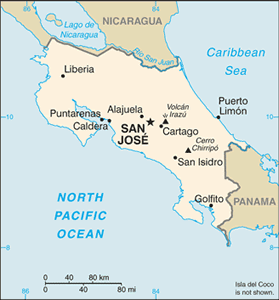The Geography of Costa Rica
The Geography of Costa Rica
Costa Rican Geography
Location: Central America, bordering both the Caribbean Sea and the North Pacific Ocean, between Nicaragua and Panama
Geographic coordinates: 10 00 N, 84 00 W
Map references: Central America and the Caribbean
Area: total: 51,100 sq km land: 50,660 sq km water: 440 sq km note: includes Isla del Coco
Area - comparative: slightly smaller than West Virginia
Land boundaries: total: 639 km border countries: Nicaragua 309 km, Panama 330 km
Coastline: 1,290 km
Maritime claims: territorial sea: 12 nm exclusive economic zone: 200 nm continental shelf: 200 nm
Climate: tropical and subtropical; dry season (December to April); rainy season (May to November); cooler in highlands
Terrain: coastal plains separated by rugged mountains including over 100 volcanic cones, of which several are major volcanoes
Elevation extremes: lowest point: Pacific Ocean 0 m highest point: Cerro Chirripo 3,810 m
Natural resources: hydropower
Land use: arable land: 4.4% permanent crops: 5.87% other: 89.73% (2005)
Irrigated land: 1,080 sq km (2003)
Natural hazards: occasional earthquakes, hurricanes along Atlantic coast; frequent flooding of lowlands at onset of rainy season and landslides; active volcanoes
Environment - current issues: deforestation and land use change, largely a result of the clearing of land for cattle ranching and agriculture; soil erosion; coastal marine pollution; fisheries protection; solid waste management; air pollution
Environment - international agreements: party to: Biodiversity, Climate Change, Climate Change-Kyoto Protocol, Desertification, Endangered Species, Environmental Modification, Hazardous Wastes, Law of the Sea, Marine Dumping, Ozone Layer Protection, Wetlands, Whaling signed, but not ratified: Marine Life Conservation
Geography - note: four volcanoes, two of them active, rise near the capital of San Jose in the center of the country; one of the volcanoes, Irazu, erupted destructively in 1963-65


